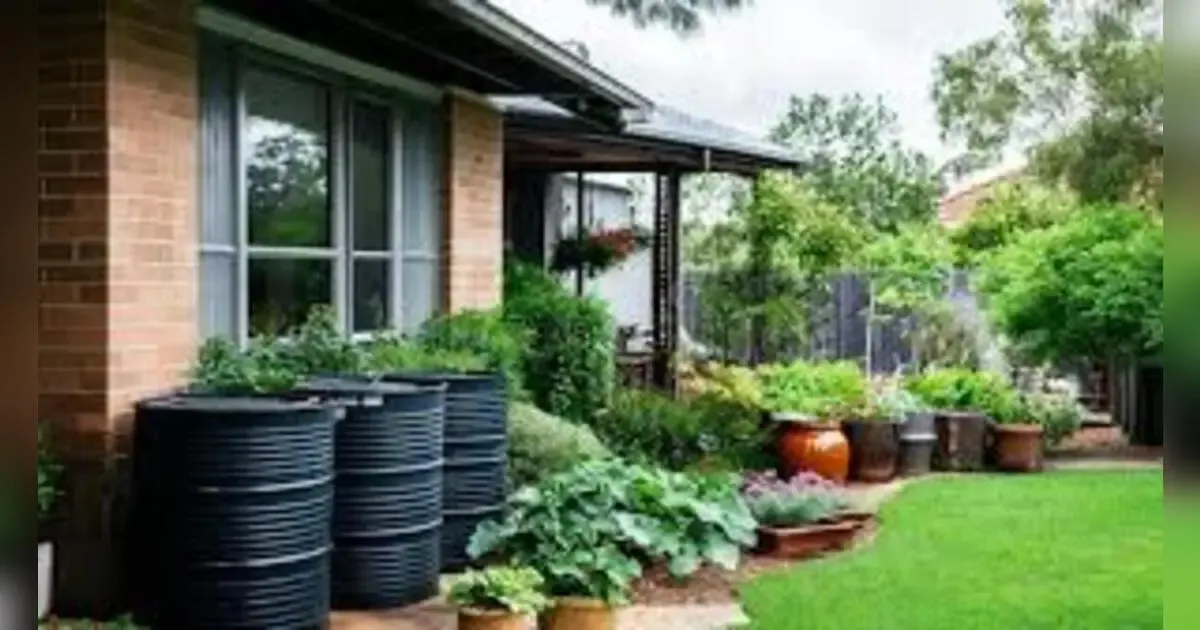Water collecting gives a maintainable way to flood gardens, diminishing water costs and moderating assets. From straightforward rain barrels to progressed frameworks, these arrangements back plant wellbeing, eco-friendly arranging, and water preservation.... ..
Rainwater Harvesting Systems for Home Gardens
Introduction
In later a long time, water deficiency has gotten to be a genuine issue, and whereas water gathering isn't an unused hone, it is one that's both simple to use and sustainable for property holders to preserve to assist keep up their gardens. Water gathering may be a strategy that includes the establishment of water catchments frameworks to collect water and store it for utilize afterward when require emerges by lessening weight on the mains supply. In addition to helping homeowners decrease their water bill, rainwater harvesting is also humane because it has several more benefits: it decreases the amount of stormwater runoff, saves energy, and provides plants with water full of minerals. Here, we will briefly discuss the different techniques of rain water harvesting for home garden, their importance and how you can start a rain water harvesting system of choice for gardening.
Why Rainwater Harvesting?
There are so many benefits of rainwater harvesting that make the entire process worthwhile for any gardener that is a bit conservation inclined. Tap water is often more recommendable for plants than rainwater, because the latter is chemically cleaner and contains no additives. For example, it will mix with rainwater, which is slightly acidic and has the ability to influence the soil pH and it also contains not less than two minerals that are vital for the maintenance of the health of plants. Rainwater is quite useful when used in the garden because it means that less treated water is used, thus less energy is used in the purification and transportation of water from the sources to your place of residence. It also controls flood water through rainwater harvesting systems reducing soil erosion and the pollutants discharged into local water bodies. The positive outcomes rated by the gardeners are not limited by the aspect of the environmental impact, which they reached by having a direct access to the supply of water and using it for watering the plants by periods of drought.
Types of Rainwater Harvesting Systems
Water collecting frameworks change in complexity, from straightforward barrel collection setups to more perplexing underground capacity frameworks. Understanding the distinctive choices can assist you select the leading framework for your needs and accessible space.
1. Rain Barrels:
Typically, the only and most prevalent water collection strategy for domestic gardens. Rain barrels are put underneath downspouts to capture water from the roof. They typically hold between 50 and 100 gallons and are prepared with spigots for simply get to. Rain barrels can be associated in an arrangement to extend capacity capacity and are perfect for little gardens or as a supplementary water source.
2. Dry Framework:
Comparable to rain barrels, a dry framework comprises of a bigger, above-ground tank set specifically beneath a downspout. The tank fills with water as it were amid precipitation, subsequently the term “dry” when not in utilize. This framework is basic to introduce, cost-effective, and works well for mortgage holders with bigger gardens requiring more water capacity than rain barrels can give.
3. Damp Framework:
A damp framework is an underground pipe organize that interface numerous downspouts to a single capacity tank, regularly found at a lower height. This plan permits water to stream into the tank indeed in the event that it's situated absent from the house. A damp framework is perfect for bigger gardens with numerous collection points and gives the next volume of water storage. However, it requires broader establishment, counting underground channeling and a tank, making it a higher-cost choice.
4. Green Rooftops:
In spite of the fact that not a coordinate water collecting strategy, green rooftops are an eco-friendly expansion to homes that back water administration. Vegetation planted on the roof retains water, helping reduce runoff whereas making a lavish, green environment that protecting the domestic. Overabundance water can be coordinated into a collection framework, making a half breed approach that combines water collecting and economical material.
Selecting the Right Rainwater Harvesting System
When it comes to the selection of rain water harvesting system that are appropriate for use in your compound; it is determined by elements such as: Water demand in the garden, space and the money that you are willing to spend. Installing a rain barrel system can be as complex as requiring a wet system or several dry tanks depending on the size of the small home gardens. Also think of how regular rain is in your region the regions with little rain at times can take a long time before they can get the next rain and therefore you may require more space for storage. Also consider the height of your downspouts, as a longer downspout will give more water pressure to push water through hoses and irrigation lines.
Rain Barrels for the Garden
Installing a rain barrel is simple and within reach of most homeowners. First of all, you have to buy a strong rain barrel with spigot, overflow provision and a lid to lighten the load of sediments. Sentry to get the barrel in the right position – direct the downspout of a building so that it flows into the barrel outlet. Most barrels are fitted with diverter kits that help throw excess water to other barrels or drainage spots once the barrel is full. This is also a good point at which to raise the barrel up in its stand slightly, to enhance the flow of water from the tap down into watering cans and hoses. To ensure that mosquitoes do not breed in the barrel, any spaces that the barrel lid and openings might allow should be properly covered with some very tight mesh work and the barrel lid should be tightly closed when the barrel is not in use.
Installing a Dry or Wet Rainwater Harvesting System
Purchasing a dry system may be easier, but to put up a completely wet system, a professional may be needed to dig and lay the pipes for a wet system. The first step is to layout your downspouts and determine where the storage tank should be located. In a dry system the tank should be nearly to a downspout so that water flows directly into the tank. For a wet system, design for down pipes from several down spouts to an underground storage tank. This approach is most appropriate when in large gardens and special properties whereby there could be different collection points.
Maintenance Tips for Rainwater Harvesting Systems
Regular maintenance is important in that your rainwater harvesting system is well functioning and has no presence of microorganisms. Often it is seen that the gutters and downspouts are blocked with leaves, dirt and debris, so clean them frequently. Empty and clean rains boots and storage tanks after some time so that you can avoid bad odors from algae and accumulated sediments. In regions of low temperatures, barrels, and tanks should be destressed and drained to prevent the occurrence of a crack due to water solidification. If the wet systems have underground piping, then it is recommended that the system be flushed at some instances to avoid blockage. This is because by doing some little efforts in cleaning the water and taking good care of the structures you shall notice that, your rain water harvesting system shall be able to produce clean water for the plants as well as be long lasting.
Using Rainwater in the Garden
Direct use of rain water is that one can directly pour it over the plants using watering can or use hose attached to the spigot if you have adequate pressure. In the same aspect, drip irrigation systems can be linked to rain barrels or tanks to help give a continuous supply of water to plants and avoid wastage. When opting for bigger tanks, they suggest installing another small pump because the pressure in wide gardens or areas, which are far from the tank, will be higher. It is now safe for ornamental plants, vegetable gardens, lawns and many other plants due to its natural mineral contents.
Combining Rainwater Harvesting with Sustainable Gardening Practices
Rainwater harvesting for gardening is a perfect match with other measures that help preserve water and create the environment for plant growth. Some of the benefits of mulching garden beds include conserving moisture for the plants; watering will be done at a lesser frequency than usual, and rain water will last longer. The use of grouped plants according to the water requirements results into effective watering areas which reduces wastage and utilizes rain water stored for use. Native and drought resistant plants specifically prefer rainwater and therefore, are suitable to be utilized in rainwater gardens because they need minimal irrigation most of the time. Rain water harvesting also promotes organic farming since the water does not contain chemicals that are added to water supply.
Benefits of Rainwater Harvesting Beyond the Garden
Apart from the garden benefits of rainwater harvesting, there are other environmental benefits of the practice. Through rainwater harvesting, people save water for use in their homes and preserve the limited public supplies and energy resources. rain water management is an effective way through which the burden of drainage systems in urban areas is relieved, whereby incidences if flooding, erosion and pollutants are prevented. As much as people strive to do all they can to conserve the environment at the comfort of their homes, rainwater harvesting is one of the easiest yet effective practices that will make a great difference to enhance accelerated growth in the home garden.
Rainwater Harvesting Regulations and Considerations
It is most important to learn any rules or policies of the rainwater harvesting system that applied in your area before installing the system. Some places have laws on use and harvesting of water since the water from roofs can impact on the water sources below and the supply of water. Find out if there are any regulation or permits required for rainwater harvesting in your area and make sure you meet them. Also, think about the quality of water you are using, some materials of your roof might disperse chemicals such as asphalt. If you’re going to use the water for the purpose of vegetable gardening it is advised to use safe roofing materials, and if needed the water can be further purified.
Conclusion
Rain water harvesting is hence the best cheapest and most natural technique of water conservation that enable homeowners to provide natural water supply for their gardens. This of rainwater collection and fitting it to different uses help cut out the municipal water supply, save cash and make the environment go green with better health. Residents have the choice of basic rain barrels to more elaborate systems to soak the ground, there is a product that can meet most South African homes’ needs. The use of rainwater along with prudent garden practices ensures efficient use of available water as well as beauty of your yard. Using a rain water harvesting system is therefore more than just a boost to your plants but a contribution to a greater cause of environmental production.


























